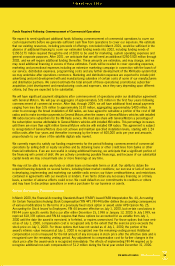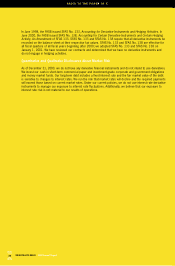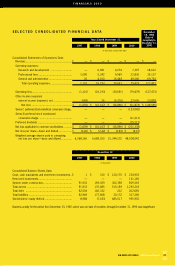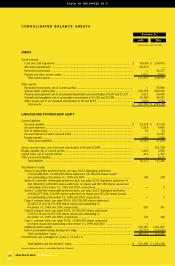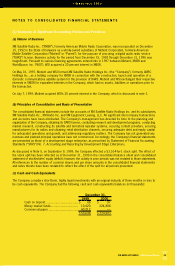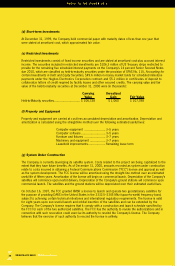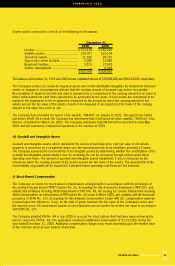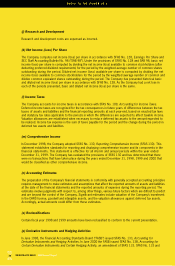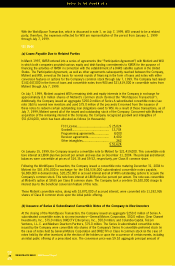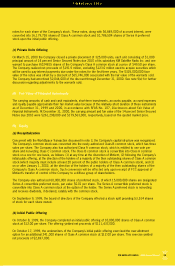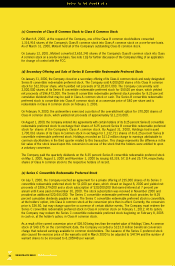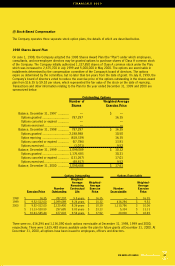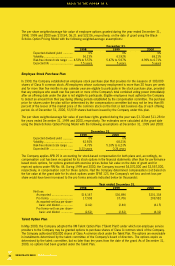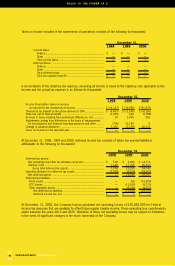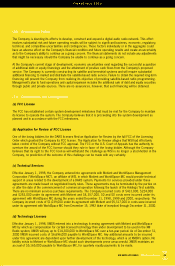XM Radio 2000 Annual Report Download - page 37
Download and view the complete annual report
Please find page 37 of the 2000 XM Radio annual report below. You can navigate through the pages in the report by either clicking on the pages listed below, or by using the keyword search tool below to find specific information within the annual report.
RADiO TO THE POWER OF X
XM SATELLiTE RADiO 2000 Annual Report
(j) Research and Development
Research and development costs are expensed as incurred.
(k) Net Income (Loss) Per Share
The Company computes net income (loss) per share in accordance with SFAS No. 128, Earnings Per Share and
SEC Staff Accounting Bulletin No. 98 (“SAB 98”). Under the provisions of SFAS No. 128 and SAB 98, basic net
income (loss) per share is computed by dividing the net income (loss) available to common stockholders (after
deducting preferred dividend requirements) for the period by the weighted average number of common shares
outstanding during the period. Diluted net income (loss) available per share is computed by dividing the net
income (loss) available to common stockholders for the period by the weighted average number of common and
dilutive common equivalent shares outstanding during the period. The Company has presented historical basic
and diluted net income (loss) per share in accordance with SFAS No. 128. As the Company had a net loss in
each of the periods presented, basic and diluted net income (loss) per share is the same.
(l) Income Taxes
The Company accounts for income taxes in accordance with SFAS No. 109, Accounting for Income Taxes.
Deferred income taxes are recognized for the tax consequences in future years of differences between the tax
bases of assets and liabilities and the financial reporting amounts at each year-end, based on enacted tax laws
and statutory tax rates applicable to the periods in which the differences are expected to affect taxable income.
Valuation allowances are established when necessary to reduce deferred tax assets to the amount expected to
be realized. Income tax expense is the sum of taxes payable for the period and the change during the period in
deferred tax assets and liabilities.
(m) Comprehensive Income
In December 1998, the Company adopted SFAS No. 130, Reporting Comprehensive Income (SFAS 130). This
statement establishes standards for reporting and displaying comprehensive income and its components in the
financial statements. This statement is effective for all interim and annual periods within the year ended
December 31, 1999. The Company has evaluated the provisions of SFAS 130 and has determined that there
were no transactions that have taken place during the years ended December 31, 1998, 1999 and 2000 that
would be classified as other comprehensive income.
(n) Accounting Estimates
The preparation of the Company’s financial statements in conformity with generally accepted accounting principles
requires management to make estimates and assumptions that affect the reported amounts of assets and liabilities
at the date of the financial statements and the reported amounts of expenses during the reporting period. The
estimates involve judgments with respect to, among other things, various future factors which are difficult to predict
and are beyond the control of the Company. Significant estimates include valuation of the Company’s investment
in the DARS license, goodwill and intangible assets, and the valuation allowances against deferred tax assets.
Accordingly, actual amounts could differ from these estimates.
(o) Reclassifications
Certain fiscal year 1998 and 1999 amounts have been reclassified to conform to the current presentation.
(p) Derivative Instruments and Hedging Activities
In June 1998, the Financial Accounting Standards Board (‘‘FASB’’) issued SFAS No. 133, Accounting for
Derivative Instruments and Hedging Activities. In June 2000 the FASB issued SFAS No. 138, Accounting for
Certain Derivative Instruments and Certain Hedging Activity, an amendment of SFAS 133. SFAS No. 133 and
36


